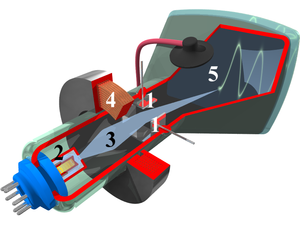
Back Ossilloskoop Afrikaans راسم إشارة Arabic Osciloscopiu AST Osiloskop Azerbaijani Асцылограф Byelorussian Асцылёграф BE-X-OLD Осцилоскоп Bulgarian অসিলোস্কোপ Bengali/Bangla Osciloskop BS Oscil·loscopi Catalan

- Deflection voltage electrodes
- Electron gun
- Electron beam
- Focusing coil
- Phosphor-coated inner side of the screen

An oscilloscope (sometimes abbreviated CRO, for cathode ray oscilloscope, or commonly just scope or O-scope) is a piece of electronic equipment that lets you see changes or waveform in signal voltage. For example, if you want to see the signal a small electronic timer was producing, you could connect it to an oscilloscope and see.
Usually, it shows a two-dimensional graph of one or more electrical potential differences on the vertical axis. These graphs are plotted with time or some other voltage along horizontal axis.